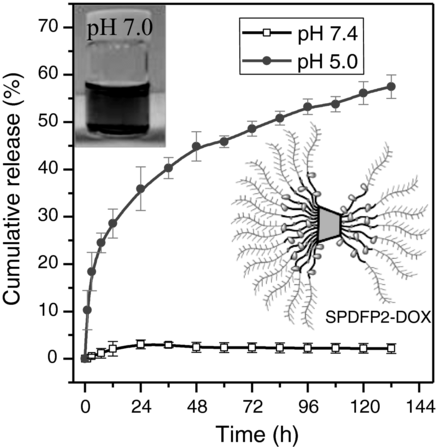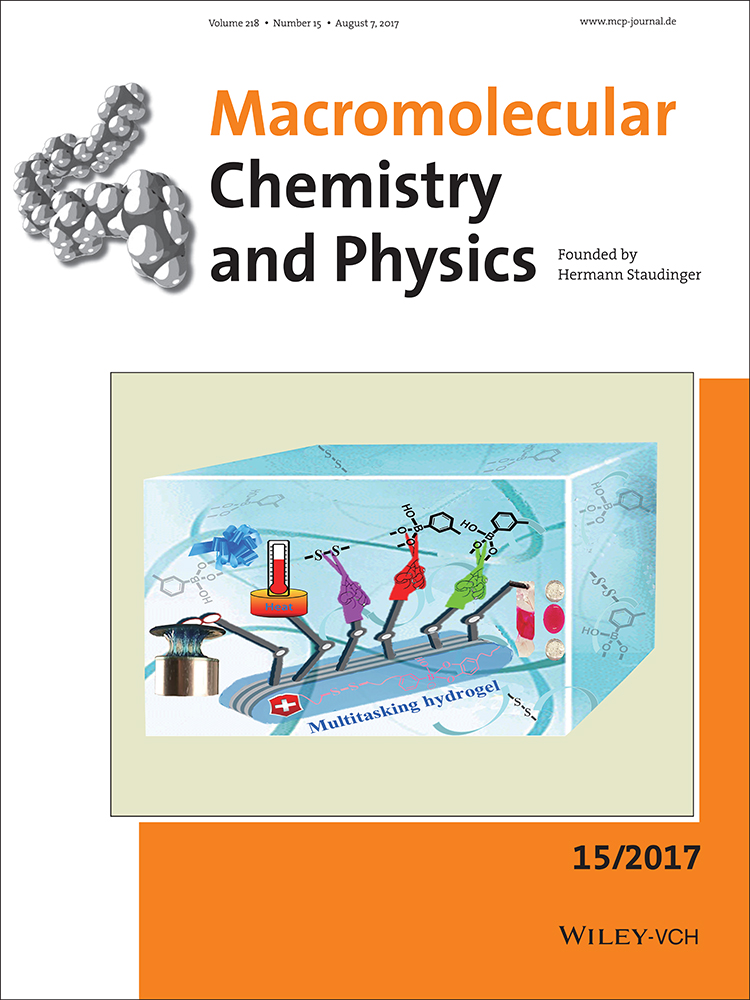Dual pH-Sensitive DOX-Conjugated Cyclodextrin-Core Star Nano-Copolymer Prodrugs
Yu Hou
Key Laboratory of Macromolecular Science and Technology of Shaanxi Province, Department of Applied Chemistry, Northwestern Polytechnical University, Xi'an, 710072 P. R. China
The Key Laboratory of Space Applied Physics and Chemistry, Ministry of Education, School of Science, Northwestern Polytechnical University, Xi'an, 710072 P. R. China
Search for more papers by this authorCorresponding Author
Yuyang Liu
Key Laboratory of Macromolecular Science and Technology of Shaanxi Province, Department of Applied Chemistry, Northwestern Polytechnical University, Xi'an, 710072 P. R. China
The Key Laboratory of Space Applied Physics and Chemistry, Ministry of Education, School of Science, Northwestern Polytechnical University, Xi'an, 710072 P. R. China
E-mail: [email protected]Search for more papers by this authorShuangshuang Sun
Key Laboratory of Macromolecular Science and Technology of Shaanxi Province, Department of Applied Chemistry, Northwestern Polytechnical University, Xi'an, 710072 P. R. China
The Key Laboratory of Space Applied Physics and Chemistry, Ministry of Education, School of Science, Northwestern Polytechnical University, Xi'an, 710072 P. R. China
Search for more papers by this authorJianghu Liang
Key Laboratory of Macromolecular Science and Technology of Shaanxi Province, Department of Applied Chemistry, Northwestern Polytechnical University, Xi'an, 710072 P. R. China
The Key Laboratory of Space Applied Physics and Chemistry, Ministry of Education, School of Science, Northwestern Polytechnical University, Xi'an, 710072 P. R. China
Search for more papers by this authorYu Hou
Key Laboratory of Macromolecular Science and Technology of Shaanxi Province, Department of Applied Chemistry, Northwestern Polytechnical University, Xi'an, 710072 P. R. China
The Key Laboratory of Space Applied Physics and Chemistry, Ministry of Education, School of Science, Northwestern Polytechnical University, Xi'an, 710072 P. R. China
Search for more papers by this authorCorresponding Author
Yuyang Liu
Key Laboratory of Macromolecular Science and Technology of Shaanxi Province, Department of Applied Chemistry, Northwestern Polytechnical University, Xi'an, 710072 P. R. China
The Key Laboratory of Space Applied Physics and Chemistry, Ministry of Education, School of Science, Northwestern Polytechnical University, Xi'an, 710072 P. R. China
E-mail: [email protected]Search for more papers by this authorShuangshuang Sun
Key Laboratory of Macromolecular Science and Technology of Shaanxi Province, Department of Applied Chemistry, Northwestern Polytechnical University, Xi'an, 710072 P. R. China
The Key Laboratory of Space Applied Physics and Chemistry, Ministry of Education, School of Science, Northwestern Polytechnical University, Xi'an, 710072 P. R. China
Search for more papers by this authorJianghu Liang
Key Laboratory of Macromolecular Science and Technology of Shaanxi Province, Department of Applied Chemistry, Northwestern Polytechnical University, Xi'an, 710072 P. R. China
The Key Laboratory of Space Applied Physics and Chemistry, Ministry of Education, School of Science, Northwestern Polytechnical University, Xi'an, 710072 P. R. China
Search for more papers by this authorAbstract
Herein this study reports dual pH-sensitive doxorubicin (DOX)-conjugated β-cyclodextrin-core star copolymers with tailoring properties such as direct water-solubility and stability prior to reaching target sites. For these purposes, three kinds of novel well-defined β-cyclodextrin-core poly(2-(diethylamino)ethyl methacrylate-co-4-formylphenyl methacrylate)-b-poly(poly(ethylene glycol) methyl ether methacrylate) star copolymers (CD-star-P(DEA-co-FPMA)-b-PPEGMA, SPDFP1–3) with different poly(ethylene glycol) methyl ether methacrylate contents are designed and synthesized by atom transfer radical polymerization (ATRP) strategy. 4-Formylphenyl methacrylate is introduced into the inner arm block of the star copolymers for conjugating DOX by imine bond formation. Interestingly, the DOX-conjugated β-cyclodextrin-core star copolymers not only can directly dissolve in aqueous buffer solution of pH 7.0 to form unimolecular micelles without any aid of organic solvent, but also exhibit strong pH-dependent DOX release. At normal pH 7.4 the DOX amount released is very small, whereas at pH 5.0 DOX can be released. By selecting SPDFP2–DOX as a representative, it is found that the SPDFP2–DOX micelles show less cytotoxicity compared to carrier-free DOX and can be internalized by HeLa cells. It is expected that the exploration can provide new strategy for preparing drug delivery system.
Supporting Information
| Filename | Description |
|---|---|
| macp201700068-sup-0001-S1.pdf666.9 KB | Supplementary |
Please note: The publisher is not responsible for the content or functionality of any supporting information supplied by the authors. Any queries (other than missing content) should be directed to the corresponding author for the article.
References
- 1V. Torchilin, Adv. Drug Delivery Rev. 2011, 63, 131.
- 2K. Kataoka, A. Harada, Y. Nagasaki, Adv. Drug Delivery Rev. 2012, 64, 37.
- 3A. Rösler, G. W. M. Vandermeulen, H.-A. Klok, Adv. Drug Delivery Rev. 2012, 64, 270.
- 4Y. Li, K. Xiao, W. Zhu, W. Deng, K. S. Lam, Adv. Drug Delivery Rev. 2014, 66, 58.
- 5H. Gao, Macromol. Rapid Commun. 2012, 33, 722.
- 6J. Zhu, Y. Liu, L. Xiao, P. Zhou, Macromol. Chem. Phys. 2016, 217, 773.
- 7Y. Cai, Y.-Y. Liu, Macromol. Chem. Phys. 2013, 214, 882.
- 8M. Prabaharan, J. J. Grailer, S. Pilla, D. A. Steeber, S. Gong, Biomaterials 2009, 30, 5757.
- 9Z. Xu, S. Liu, H. Liu, C. Yang, Y. Kang, M. Wang, Chem. Commun. 2015, 51, 15768.
- 10T. Jia, S. Huang, C. Yang, M. Wang, Mol. Pharmaceutics, DOI: 10.1021/acs.molpharmaceut.6b00708.
- 11X. Li, Y. Qian, T. Liu, X. Hu, G. Zhang, Y. You, S. Liu, Biomaterials 2011, 32, 6595.
- 12G. Kreutzer, C. Ternat, T. Q. Nguyen, C. J. G. Plummer, J.-A. E. Månson, V. Castelletto, I. W. Hamley, F. Sun, S. S. Sheiko, A. Herrmann, L. Ouali, H. Sommer, W. Fieber, M. I. Velazco, H.-A. Klok, Macromolecules 2006, 39, 4507.
- 13K. Knop, G. M. Pavlov, T. Rudolph, K. Martin, D. Pretzel, B. O. Jahn, D. H. Scharf, A. A. Brakhage, V. Makarov, U. Müllmann, F. H. Schacher, U. S. Schubert, Soft Matter 2013, 9, 715.
- 14X. Hu, G. Liu, Y. Li, X. Wang, S. Liu, J. Am. Chem. Soc. 2015, 137, 362.
- 15Y. Y. Liu, S. Lan, L. Q. Xiao, Macromol. Chem. Phys. 2015, 216, 749.
- 16L. Niu, Y. Liu, Y. Hou, W. Song, Y. Wang, Polym. Chem. 2016, 7, 3406.
- 17W. Wu, W. Wang, J. Li, Prog. Polym. Sci. 2015, 46, 55.
- 18X. Chen, W. Wu, Z. Guo, J. Xin, J. Li, Biomaterials 2011, 32, 1759.
- 19K. M. Xiu, J. J. Yang, N. N. Zhao, J. S. Li, F. J. Xu, Acta Biomater. 2013, 9, 4726.
- 20Y. Hu, Y. Zhu, W. T. Yang, F. J. Xu, ACS Appl. Mater. Interfaces 2013, 5, 703.
- 21P. F. Gou, W. P. Zhu, Z. Q. Shen, Polym. Chem. 2010, 1, 1205.
- 22L. Y. Qiu, R. J. Wang, C. Zheng, Y. Jin, L. Q. Jin, Nanomedicine 2010, 5, 193.
- 23Y. Y. Liu, Y. B. Zhong, J. K. Nan, W. Tian, Macromolecules 2010, 43, 10221.
- 24Z. Ge, J. Xu, J. Hu, Y. Zhang, S. Liu, Soft Matter 2009, 5, 3932.
- 25A. Wycisk, A. Döring, M. Schneider, M. Schönhoff, D. Kuckling, Polymers 2015, 7, 921.
- 26Q. Zhang, G.-Z. Li, C. Remzi Becer, D. M. Haddleton, Chem. Commun. 2012, 48, 8063.
- 27X. Pang, L. Zhao, M. Akinc, J. K. Kim, Z. Lin, Macromolecules 2011, 44, 3746.
- 28Y. Wang, Y. Liu, J. Liang, M. Zuo, RSC Adv. 2017, 7, 11691.
- 29V. Delplace, P. Couvreur, J. Nicolas, Polym. Chem. 2014, 5, 1529.
- 30H. Wei, R. X. Zhuo, X. Z. Zhang, Prog. Polym. Sci. 2013, 38, 503.
- 31F. Meng, Y. Zhong, R. Cheng, C. Deng, Z. Zhong, Nanomedicine 2014, 9, 487.
- 32J. Liu, H. Duong, M. R. Whittaker, T. P. Davis, C. Boyer, Macromol. Rapid Commun. 2012, 33, 760.
- 33J. Mao, Y. Li, T. Wu, C. Yuan, B. Zeng, Y. Xu, L. Dai, ACS Appl. Mater. Interfaces 2016, 8, 17109.
- 34Y. Yu, C. K. Chen, W.-C. Law, E. Weinheimer, S. Sengupta, P. N. Prasad, C. Cheng, Biomacromolecules 2014, 15, 524.
- 35L. Qiu, C.-Y. Hong, C.-Y. Pan, Int. J. Nanomed. 2015, 10, 3623.
- 36X. Ke, D. J. Coady, C. Yang, A. C. Engler, J. L. Hedrick, Y. Y. Yang, Polym. Chem. 2014, 5, 2621.
- 37S. Aryal, J. J. Grailer, S. Pilla, D. A. Steeberb, S. Gong, J. Mater. Chem. 2009, 19, 7879.
- 38X. Yang, H. Hong, J. J. Grailer, I. J. Rowland, A. Javadi, S. A. Hurley, Y. Xiao, Y. Yang, Y. Zhang, R. J. Nickles, W. Cai, D. A. Steeber, S. Gong, Biomaterials 2011, 32, 4151.
- 39W. Wu, Q. Zhang, J. Wang, M. Chen, S. Li, Z. Lin, J. Li, Polym. Chem. 2014, 5, 5668.
- 40W. Wu, M. Chen, J. Wang, Q. Zhang, S. Li, Z. Lin, J. Li, RSC Adv. 2014, 4, 30780.
- 41P. Zhou, Y. Y. Liu, L. Y. Niu, J. Zhu, Polym. Chem. 2015, 6, 2934.
- 42Y. Li, H. Yu, Y. Qian, J. Hu, S. Liu, Adv. Mater. 2014, 26, 6734.
- 43N. Kuhl, S. Bode, R. K. Bose, J. Vitz, A. Seifert, S. Hoeppener, S. J. Garcia, S. Spange, S. van der Zwaag, M. D. Hager, U. S. Schubert, Adv. Funct. Mater. 2015, 25, 3295.
- 44B. García-Acosta, F. García, J. M. García, R. Martínez-Máñez, F. Sancenón, N. San-José, J. Soto, Org. Lett. 2007, 9, 2429.





